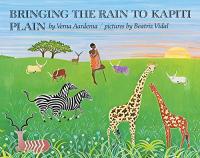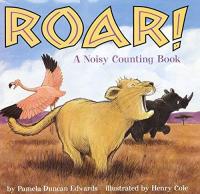
This large land animal is introduced through crisp, easy-to-follow text and realistic illustrations. Information presented will satisfy casual readers and is likely to inspire further reading.
Elephants of Africa

The Whydah Galley was a real, fast-moving ship that was involved in 18th century slave trade, transporting people from Africa to the Caribbean until captured by pirates. How the Whydah and her treasures were discovered by underwater archaeologists is revealed in informal text and dramatic illustrations. Additional resources are included.
Real Pirates: The Untold Story of the Whydah from Slave Ship to Pirate Ship

Tales drawn from the oral tradition are retold with verve and musical language certain to delight listeners of all ages. Bryan’s paintings decorate each tale, bringing characters and plot vividly to life.
Ashley Bryan’s African Tales, Uh-huh

For many years, Lekuton taught school in the DC area, but before that he grew up in the Kenyan desert. Now, he’s back in Kenya, serving in parliament. This is an autobiography of his Kenyan childhood.
Facing the Lion: Growing up Maasai on the African Savanna

To gain wisdom, Zomo, the small black rabbit, successfully accomplishes a series of impossible tasks assigned by the Sky God in this traditional Nigerian tale. Richly colored, stylized illustrations accompany the simple text — ideal for sharing aloud.
Zomo the Rabbit: A Trickster Tale from West Africa

Sungura, a resourceful hare, and grouchy Leopard decide to build their homes in the same spot. How Sungura outwits Leopard to get him out is told in lively language with boldly lined illustrations that suggest the place in which the animals live and work.
Sungura and Leopard: A Swahili Trickster Tale

Anansi is a known charlatan, so he gets little sympathy when Turtle eats all of the fish that Anansi has learned to catch. But the reader knows that the trickster has not really learned a lesson! Sly humor abounds in both text and image in this lively retelling.
Anansi Goes Fishing

Stylized illustrations and rhyming text take readers on a counting journey led by three Masai children through their richly diverse east African country. Along the way, they count the animals (in English and Swahili) that live in the grasslands. Additional information and a map are included.
We All Went on Safari: A Counting Journey Through Tanzania

When a tsunami orphans a young hippopotamus, a group of concerned Malidi (on the east coast of Kenya) villagers figure out how to capture the 600 pound baby thus beginning his new life in an animal sanctuary with a new and unlikely companion — a 130 year old tortoise named Mzee. Full color photographs and straightforward text are used in this inspiring, appealing and true story told first by a young girl and her father.
Owen and Mzee: The True Story of a Remarkable Friendship

BaMusa takes a break from selling his hats — only to have them stolen by mischievous monkeys. Told in rhythmic language sprinkled with words from Mali, BaMusa’s work to retrieve his hats is illustrated with strong line and bold form.
Hatseller and the Monkeys

The tale of herdsman Ki-pat is set on a dry African plain and is told in the familiar cadence of “The House that Jack Built”. Animals are introduced, tension builds and the resolution pours forth as the rhyme builds. Stylized illustrations create place and mood in this engaging verse.
Bringing the Rain to Kapiti Plain

Even the strongest man of all can be outmatched, as Shadusa learns. This retelling of a Nigerian tale is told with cut paper illustrations carefully placed in comic book-like panels, which emphasize the humor and lesson of this super-sized tall tale.
Master Man: A Tall Tale of Nigeria

An imagined journey on the Nile River in the time of Ramses II (around 1279-1213 BC) begins when 11-year-old Dedia and his father travel to a wedding in Piramesse. What they see along the way is minutely detailed and clearly labeled illustrations in an oversized format.
Egypt: In Spectacular Cross-Section

Have you ever wondered how the Moon was placed in the sky? According to this Ashanti tale, Nyame, the god of all things, put it there when Anansi could not decide which of his sons deserved it. Brilliant illustrations accompany this classic retelling of a traditional tale.
Anansi the Spider: A Tale from the Ashanti

A little lion cub cannot understand why no one, from 1 red monkey to 8 brown gazelles, wants to play with him. His roar is not frightening to the 9 yellow lion cubs he meets, however, and the ROAR of 10 playful lions sends all the animals stampeding away! The rhythmic text with the repeated “roar” encourages participation as children follow the energetic, gently humorous illustrations and explore animal habitats as well as numbers and colors.
Roar! A Noisy Counting Book

Mufaro had two beautiful daughters but each had very different personalities. Manyara was as haughty Nyasha was kind — and the behavior of one led to a royal wedding. Lush illustrations set in Zimbabwe and a straightforward telling make this a memorable book sometimes likened to a “Cinderella” story.
Mufaro’s Beautiful Daughters

A head by itself can’t do much – until he meets arms, body, and legs. Together they discover how delicious life can be. Bold colors and broad forms help create the humor in this engaging creation story from the author’s Dan tribe of Liberia.
Head, Body, Legs: A Story from Liberia

A grandmother tells her granddaughter the history of baskets, going all the way back to Africa. The circular history of a people and of families is suggested in gentle text and evocative watercolors.
